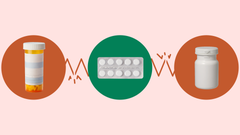
clonazepam
Clonazepam (Klonopin) is a benzodiazepine. It's approved to treat seizures in adults and children, and panic disorder in adults only. Clonazepam (Klonopin) is taken by mouth, typically two or three times a day. It's also available as orally disintegrating tablets (ODTs) for people who have trouble swallowing. Some common side effects of this medication include drowsiness, dizziness, and poor movement control. Before stopping clonazepam (Klonopin), speak with your prescriber to come up with a plan to lower your dose slowly over time to avoid withdrawal symptoms.

What is Clonazepam (Klonopin)?
What is Clonazepam (Klonopin) used for?
How Clonazepam (Klonopin) works
Clonazepam (Klonopin) is a benzodiazepine. Researchers think it calms the brain by reducing signaling in your brain cells. This can help treat seizures and ease symptoms of a panic attack.
Drug Facts
More on Clonazepam (Klonopin) essentials

Get your GoodRx coupon

What are the risks and warnings for Clonazepam (Klonopin)?
Clonazepam (Klonopin) can cause some serious health issues. This risk may be even higher for certain groups. If this worries you, talk to your doctor or pharmacist about other options.

Sedation and difficulty breathing
Risk factors: Taking clonazepam (Klonopin) with opioids or alcohol
Taking clonazepam (Klonopin) with opioids or alcohol can cause severe drowsiness, difficulty breathing, coma and can even result in death. If you've already been prescribed an opioid, have a discussion with your HCP to make sure the combination with clonazepam (Klonopin) is as safe as possible. If you develop difficulty breathing, get medical attention right away.

Potential for misuse, addiction, dependence, and withdrawal
Risk factors: History of substance misuse | Drinking alcohol | Taking higher doses of clonazepam (Klonopin) | Taking clonazepam (Klonopin) for a long period of time | Stopping clonazepam (Klonopin) suddenly
Taking clonazepam (Klonopin) can expose you to the possible risk for misuse, and addiction to this medication. Taking clonazepam (Klonopin) more often or at a higher dose than prescribed can lead to life-threatening overdose. If you or a loved one suspects any of the above, get medical help right away.
Additionally, if you're taking clonazepam (Klonopin) for a long period of time or at a high dose, you're at risk for dependence and withdrawal. This is when your body depends on the medication to function, and can happen when you suddenly stop taking the medication. This can lead to serious problems, including seizures. Don't stop taking this medication without first talking to your prescriber. To lower your risk of dependence and overdose, take clonazepam (Klonopin) only as prescribed.

Suicidal thoughts or behaviors
Risk factors: History of depression
Clonazepam (Klonopin) can raise your risk for new or worsening depression and behavior changes. Watch for new or worsening signs of depression, suicidal thoughts or behavior, or any unusual changes in mood or behavior while taking this medication. Get medical care right away if you notice any of these changes.

Effect on driving and concentration
Risk factors: Drinking alcohol | Taking other medications that cause drowsiness
Taking clonazepam (Klonopin) can make you feel sleepy, and affect your concentration and focus. Avoid activities that require you to be alert, like driving or operating machinery, until you know how the medication affects you.

Harm to babies
Risk factors: Taking clonazepam (Klonopin) while pregnant
Clonazepam (Klonopin) can cause harm to your baby if you take it while pregnant. Mothers who took this medication late in their pregnancies have given birth to babies who had trouble breathing, excessive sleepiness, and poor feeding. This condition is called neonatal abstinence syndrome, and can be dangerous for your baby. If you're planning to become pregnant or are currently pregnant, speak with your HCP about safe options to treat your panic disorder or seizures.

Worsening of seizures
Risk factors: Currently have multiple types of seizure disorders | Taking clonazepam (Klonopin) for 3 months or longer
In some rare cases, clonazepam (Klonopin) could make your seizures worse. If you have more seizures than usual or your seizures get worse while taking this medication, call your prescriber right away.
More on Clonazepam (Klonopin) warnings

What are the side effects of Clonazepam (Klonopin)?
Common Side Effects
- Drowsiness (50%)
- Poor movement control, clumsiness (30%)
- Behavior problems (25%)
- Drowsiness (up to 50%)
- Dizziness (up to 12%)
- Runny nose, sore throat, and other symptoms of a respiratory infection (up to 10%)
- Extreme tiredness (up to 9%)
- Poor movement control, clumsiness (up to 9%)
- Depression (up to 8%)
Other Side Effects
- Memory problems
- Sinus inflammation
- Flu-like symptoms
- Nervousness
- Muscle pain
Serious Side Effects
- Suicidal behaviors or thoughts of self-harm
- Slowed breathing
- Severe sedation: drowsiness, confusion, memory problems, slurred speech, loss of consciousness
- Withdrawal symptoms: seizures, headache, dizziness, trouble sleeping, panic attacks, depression, irritability, restlessness, hallucinations (seeing or hearing things that aren't there)
Source: Dailymed
More on Clonazepam (Klonopin) side effects
The following side effects have also been reported
Along with its needed effects, a medicine may cause some unwanted effects. Although not all of these side effects may occur, if they do occur they may need medical attention.
Check with your doctor immediately if any of the following side effects occur:
More common
Body aches or pain
chills
difficulty breathing
discouragement
dizziness
ear congestion
feeling sad or empty
headache
irritability
lack of appetite
loss of interest or pleasure
loss of voice
poor coordination
shakiness and unsteady walk
sleepiness or unusual drowsiness
tiredness
trouble concentrating
trouble sleeping
unsteadiness, trembling, or other problems with muscle control or coordination
unusual tiredness or weakness
Less common
Being forgetful
bladder pain
bloody or cloudy urine
change in speech
decrease in frequency of urination
difficulty in passing urine
difficult, burning, or painful urination
frequent urge to urinate
general feeling of discomfort or illness
joint pain
loss of appetite
lower back or side pain
mood or mental changes
muscle aches and pains
nervousness
problems in urination or increase in the amount of urine
shivering
slurred speech
sweating
trouble speaking
vomiting
Rare
Burning, crawling, itching, numbness, prickling, "pins and needles", or tingling feelings
changes in skin color
chest pain, discomfort, or tightness
cold sweats
colds
confusion
cough or hoarseness
difficulty with sleeping
dizziness, faintness, or lightheadedness when getting up suddenly from a lying or sitting position
excessive dreaming
excessive muscle tone
excitement
falling
fast, irregular, pounding, or racing heartbeat or pulse
feeling mad
feeling of unreality
flu-like symptoms
headache, severe and throbbing
lack of feeling or emotion
lack or loss of self-control
muscle stiffness
muscle tension or tightness
nightmares
pain, inflammation, or swelling in the calves, shoulders, or hands
pain or swelling in the arms or legs without any injury
pain, tenderness, or swelling of the foot or leg
partial or slight paralysis
scaling
sense of detachment from self or body
shakiness in the legs, arms, hands, or feet
skin rash
swelling around the eyes
swelling of the face, ankle, foot, or knees
thoughts of killing oneself changes in behavior
trembling or shaking of the hands or feet
uncaring
vision changes
Incidence not known
black, tarry stools
bleeding gums
blood in the urine or stools
change in consciousness
chest congestion
difficulty with coordination
double vision
drowsiness
feeling that others are watching you or controlling your behavior
feeling that others can hear your thoughts
feeling, seeing, or hearing things that are not there
hyperventilation
irregular, fast, slow, or shallow breathing
irregular, twisting uncontrolled movement of the face, hands, arms, or legs
loss of interest or pleasure
loss of memory
loss of strength or energy
loss of voice
muscle weakness
pale or blue lips, fingernails, or skin
pinpoint red spots on the skin
problems with memory
restlessness
severe mood or mental changes
sores, ulcers, or white spots on the lips or in the mouth
stomach pain or fullness
swollen glands
trouble breathing
uncontrolled eye movements
unusual behavior
unusual bleeding or bruising
unusual weakness
vivid dreams
weight loss or gain
Get emergency help immediately if any of the following symptoms of overdose occur:
Symptoms of overdose
Change in consciousness
loss of consciousness
mood or mental changes
sleepiness or unusual drowsiness
Some side effects may occur that usually do not need medical attention. These side effects may go away during treatment as your body adjusts to the medicine. Also, your health care professional may be able to tell you about ways to prevent or reduce some of these side effects. Check with your health care professional if any of the following side effects continue or are bothersome or if you have any questions about them:
Less common
Decreased interest in sexual intercourse
difficulty with swallowing
dryness or soreness of the throat
inability to have or keep an erection
longer than usual time to ejaculation of semen
loss in sexual ability, desire, drive, or performance
pain or tenderness around the eyes and cheekbones
puffiness or swelling of the eyelids or around the eyes, face, lips, or tongue
voice changes
Rare
Acid or sour stomach
ankle, knee, or great toe joint pain
belching
bleeding after defecation
blistering, burning, crusting, dryness, or flaking of the skin
bloated
blurred or loss of vision
change in color perception
cracks in the skin at the corners of the mouth
decrease or change in vision
difficulty moving
double vision
dryness of the eyes
excess air or gas in stomach or intestines
feeling of constant movement of self or surroundings
feeling of warmth
frequent bowel movements
full feeling
hair loss or thinning of the hair
halos around lights
increased watering of the mouth
indigestion
irregularities in menstruation
itching in the genital or other skin areas
itching, scaling, severe redness, soreness, or swelling of the skin
joint stiffness or swelling
leg or muscle cramps
loss of taste
night blindness
nosebleeds
overbright appearance of lights
pain in the breasts or pelvic area
pain in the leg, nape, or back
passing gas
red, sore eyes
redness of the face, neck, arms, and occasionally, upper chest
redness or swelling in the ear
sensation of spinning
smaller amount of semen ejaculated than usual
sore on the edge of the eyelid
soreness or redness around the fingernails and toenails
stomach discomfort, upset, or pain
thickening of the tongue
thirst
tooth disorder
toothache
tunnel vision
twitching of the eyes
uncomfortable swelling around the anus
worsening of acne
Incidence not known
Burning feeling in the chest or stomach
difficulty having a bowel movement (stool)
increased appetite
increased hair growth, especially on the face
increased in sexual ability, desire, drive, or performance
increased interest in sexual intercourse
sore gums
tenderness in the stomach area
Other side effects not listed may also occur in some patients. If you notice any other effects, check with your healthcare professional.
Call your doctor for medical advice about side effects. You may report side effects to the FDA at 1-800-FDA-1088.

Pros and cons of Clonazepam (Klonopin)

Pros
Taken by mouth
Less likely to cause rebound anxiety (in people with panic disorders) when stopping compared to some other benzodiazepines
Available as a lower-cost generic
Available as orally disintegrating tablet (ODT)

Cons
Taken 2 to 3 times daily
Can be habit-forming, so isn't typically used for long-term treatment
Can cause memory problems, drowsiness, dizziness, and confusion
Might not work as well for seizure control over time

Pharmacist tips for Clonazepam (Klonopin)

Take this medication exactly as your healthcare professional (HCP) has prescribed to avoid serious side effects, like slowed breathing and overdose.
Clonazepam (Klonopin) can cause dizziness and extreme drowsiness. Avoid activities that require you to be alert (like driving) until you know how it affects you.
Clonazepam (Klonopin) can sometimes cause you to salivate (drool) more. If this becomes bothersome, let your psychiatrist or HCP know.
Don't stop taking clonazepam (Klonopin) suddenly because you might get withdrawal symptoms, such as nausea, vomiting, and diarrhea. If you want to stop this medication, ask your HCP to help you do so slowly over time.
Additional tips for clonazepam (Klonopin) orally disintegrating tablets (ODT):
Peel back the foil on the blister using dry hands. If your hands are damp or wet, the moisture can cause the clonazepam (Klonopin) ODT tablet to dissolve.
Don't push the clonazepam (Klonopin) ODT tablet through the blister pack because this could break the tablet.
Place the clonazepam (Klonopin) ODT tablet on your tongue and let it dissolve with your saliva; you don't need water.
Don't swallow the clonazepam (Klonopin) ODT tablets whole and don't chew, break, or crush them because this could change the way the medication works for you.
Clonazepam (Klonopin) ODTs contain phenylalanine. If you have a condition called phenylketonuria, or PKU, let your prescriber know before taking the ODTs.

Frequently asked questions about Clonazepam (Klonopin)

How to save using GoodRx




Clonazepam (Klonopin) dosage forms
Typical dosing for Clonazepam (Klonopin)
Panic disorder:
Adults: The typical starting dose is 0.25 mg by mouth twice daily.
Seizures:
Adults: The typical starting dose is 0.5 mg by mouth three times a day. Your prescriber will raise your dose every few days until your seizures are under control.
Children: Your child’s pediatrician will determine the dose based on their body weight and age. The typical starting dose ranges from 0.01 mg/kg to 0.03 mg/kg by mouth daily, split up into 2 to 3 smaller doses taken throughout the day. The maintenance dose depends on whether your child’s seizures are under control and how well they tolerate the side effects.

Clonazepam (Klonopin) Reviews
GoodRx has partnered with PatientsLikeMe to provide reviews on the different aspects of Clonazepam (Klonopin).
Effectiveness
Learn more about the effectiveness of Clonazepam (Klonopin) based on real life experiences.
Overall Rating
Based on 882 people taking this medication
3.6
Effectiveness by condition:
panic disorder486 reviews
3.8
epilepsy156 reviews
3.2
generalized anxiety disorder151 reviews
4.0
essential myoclonus45 reviews
4.2
fibromyalgia44 reviews
3.0
Severity of side effects
Based on 2636 people taking this medication
0%
50%
100%
Top side effects
Drowsiness
8%
Sleepiness
6%
Fatigue
3%
Excessive daytime sleepiness (somnolence)
3%
Grogginess in morning
2%
Reasons people stopped taking Clonazepam (Klonopin)
Based on 1687 people who have taken this medication
Doctor's advice
27%
Did not seem to work
21%
Other
19%
Side effects too severe
18%
Course of treatment ended
8%
Personal research
5%
Change in health plan coverage
3%
Expense
2%

Interactions between Clonazepam (Klonopin) and other drugs
More on Clonazepam (Klonopin) interactions
Using this medicine with any of the following medicines is not recommended. Your doctor may decide not to treat you with this medication or change some of the other medicines you take.
- Flumazenil
Using this medicine with any of the following medicines is usually not recommended, but may be required in some cases. If both medicines are prescribed together, your doctor may change the dose or how often you use one or both of the medicines.
- Alfentanil
- Alprazolam
- Amobarbital
- Benzhydrocodone
- Bromazepam
- Bromopride
- Buprenorphine
- Butabarbital
- Butalbital
- Butorphanol
- Calcifediol
- Calcium Oxybate
- Cannabidiol
- Carbamazepine
- Carbinoxamine
- Carisoprodol
- Ceritinib
- Cetirizine
- Chloral Hydrate
- Chlorzoxazone
- Clarithromycin
- Clobazam
- Codeine
- Dantrolene
- Dihydrocodeine
- Doxylamine
- Esketamine
- Ethchlorvynol
- Fentanyl
- Flibanserin
- Fospropofol
- Gabapentin
- Gabapentin Enacarbil
- Hydrocodone
- Hydromorphone
- Ketamine
- Ketoconazole
- Lemborexant
- Levocetirizine
- Levorphanol
- Lofexidine
- Loxapine
- Magnesium Oxybate
- Meclizine
- Meperidine
- Mephenesin
- Mephobarbital
- Meprobamate
- Metaxalone
- Methadone
- Methocarbamol
- Methohexital
- Metoclopramide
- Midazolam
- Mirtazapine
- Morphine
- Morphine Sulfate Liposome
- Nalbuphine
- Orlistat
- Oxycodone
- Oxymorphone
- Pentazocine
- Pentobarbital
- Periciazine
- Phenobarbital
- Potassium Oxybate
- Pregabalin
- Primidone
- Propofol
- Remimazolam
- Scopolamine
- Secobarbital
- Sodium Oxybate
- Sufentanil
- Tapentadol
- Thiopental
- Tramadol
- Trazodone
- Zolpidem
Using this medicine with any of the following medicines may cause an increased risk of certain side effects, but using both drugs may be the best treatment for you. If both medicines are prescribed together, your doctor may change the dose or how often you use one or both of the medicines.
- Amiodarone
- Desipramine
- Ginkgo
- Nevirapine
- Rifapentine
- Ritonavir
- St John's Wort
- Theophylline

How much does Clonazepam (Klonopin) cost?

Clonazepam (Klonopin) contraindications
Severe liver problems
Narrow angle glaucoma

What are alternatives to Clonazepam (Klonopin)?
Depression in people ages 12 years and older
Generalized anxiety disorder (GAD) in people ages 7 years and older

What is the latest news about Clonazepam (Klonopin)?

Clonazepam (Klonopin) images
Get savings updates for Clonazepam (Klonopin)
Receive price alerts, news, and other messages from GoodRx about Clonazepam (Klonopin) and other healthcare topics and relevant savings offers.By signing up, I agree to GoodRx's Terms and Privacy Policy, and to receive marketing messages from GoodRx.
References
Best studies we foundAdvagen Pharma Ltd. (2023). CLONAZEPAM tablet [package insert]. DailyMed.
Alembic Pharmaceuticals Inc. (2022). CLONAZEPAM - clonazepam tablet, orally disintegrating [package insert]. DailyMed.
American Psychiatric Association. (2009). Treating panic disorder: A quick reference guide.
Anbalagan, S., et al. (2023). Neonatal abstinence syndrome. StatPearls.
Armstrong, C. (2008). ACOG Guidelines on Psychiatric Medication Use During Pregnancy and Lactation. American Family Physician.
Basit, H., et al. (2023). Clonazepam. StatPearls.
Tinker, S.C., et al. (2019). Use of benzodiazepine medications during pregnancy and potential risk for birth defects, National Birth Defects Prevention Study, 1997–2011. Birth Defects Research.
Compare other Epilepsy, Lennox-Gastaut Syndrome, Panic Disorder drugs
Browse medications
View AllResearch prescriptions and over-the-counter medications from A to Z, compare drug prices, and start saving.


















